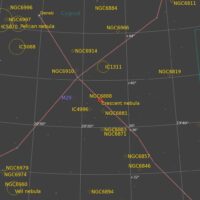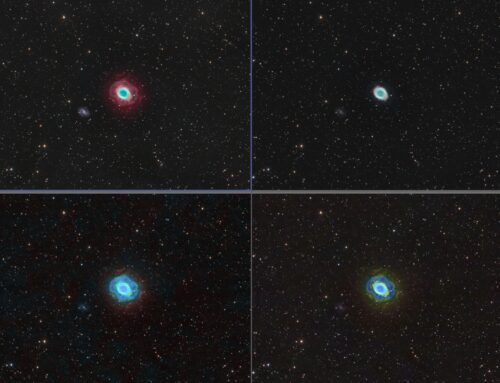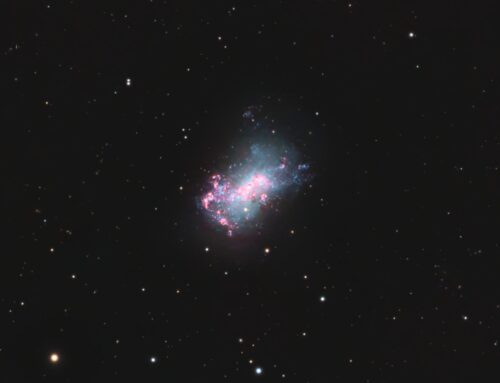NGC 6888, the Crescent Nebula
 Click image for full size version
Click image for full size version
August 20, 2023 – First light with CELESTRON 14″ EDGE HD TELESCOPE and PRIMALUCELAB 2″ LP ESATTO + ARCO ROTATOR
The Crescent Nebula is an emission nebula situated about 5,000 light years away. It lies in a patch of Milky Way that runs right through Cygnus, the Swan. The richness of the Milky Way in this region is apparent from the vast number of stars in this image. The rich reds and greens are due to glowing hydrogen and oxygen gas, respectively. The Crescent Nebula is being energized and “blown out” by energetic winds coming from the powerful central star, WR136. The WR signifies that it is a “Wolf-Rayet” star: very hot, at least 20 times the mass of the sun, and losing mass rapidly. I read that WR136 is shedding the equivalent of the Sun’s mass every 10,000 years and that it will eventually explode in a supernova! That will probably produce another very interesting nebula for our descendants to look at!
This is the first light image using a Celestron 14″ F/11 EDGE HD Schmidt-Cassegrain telescope. It is also the first-light image for a Primalucelab low-profile 2″ Esatto focuser and ARCO rotator. I’m very impressed with how all the equipment is performing together. This is more than double the focal length of any telescope I’ve used previously, so expect photos of small objects.
Tekkies:
Acquisition, focusing, and control of Paramount MX mount with N.I.N.A., TheSkyX and PHD2. Primalucelab low=profile 2″ Essato focuser and ARCO rotator. Equipment control with PrimaLuce Labs Eagle 3 (2021) and 4 (2023) Pro computer. All pre-processing and processing in PixInsight. Acquired from my SkyShed in Guelph. Average transparency and seeing. Data acquired May 12-17, 2023 in a nearly moonless sky.
Celestron 14″ EDGE HD telescope at f/11 (3,912 mm focal length) and QHY600M camera binned 2×2 with Optolong filters.
13x5m Red = 1hr05m
16x5m Green = 1hr20m
9x5m Blue = 0hr45m
55x5m Ha = 4hr35m
25x5m O3 = 2hr05m
Total: 9hr50m
Preprocessing: The WeightedBatchPreProcessing script was used to perform calibration, cosmetic correction, weighting, registration, local normalization and integration of all frames.
Colour master: A colour master was made from the Red, Green and Blue masters using ChannelCombination in RGB mode.
Gradient Removal: DynamicBackgroundExtraction was applied to the RGB, Ha and O3 masters.
Colour Calibration: ColorCalibration was used to calibrate the RGB master.
Deconvolution: BlurXterminator was used on the Ha, O3 and RGB masters with Automatic psf , and star sharpening set to 0.10 with “Correct First” selected. The same settings were used with Automatic PSF on the Color image.
Linear Noise Reduction: NoiseXterminator was applied to each image with settings Amount=0.9 and Detail=0.15
Star Removal: StarXterminator was used to remove the stars from each the RGB, Ha and O3 masters, with default settings.
Stretching: HistogramTransformation was applied to the RGB, Ha and O3 image to make pleasing images. Approximate background level after stretch was 0.10 for RGB and 0.08 for Ha and O3.
Nonlinear Processing
Addition of Ha: PixelMath was used to blend Ha into the RGB image using the following expression with parameter values a=1.2 and b=0.06.
Red: max($T[0], a*Ha)
Green: $T[1]
Blue: iif($T[0]<a*Ha, $T[2] + b * Ha, $T[2])
Addition of O3: PixelMath was used to blend O3 into the HaRGB image using the following expression with parameter values a=1.
Red: $T[0]
Green: max($T, a*O3)
Blue: max($T, a*O3)
Nonlinear Noise Reduction: NoiseXterminator was used to reduce noise in the background areas of the image with settings Amount=0.9 and Detail=0.2
Contrast Enhancement: LocalHistogramEqualization was applied three times. A Contrast Limit of 1.5 and 1 iteration was used for each LHE application (scale 20, strength 0.35; scale 90, strength 0.25; scale 150, strength 0.15).
Sharpening: A mask was used to select brighter regions of nebulosity for sharpening with MultiscaleMedianTransform (Layers 1 – 5 with strengths of 0.03, 0.05, 0.08, 0.06, and 0.03, respectively).
Star Restoration: Straight addition in PixelMath was used to combine the starless and stars-only images created with StarXterminator.
Final Steps: Background, nebula and star brightness, contrast and saturation were adjusted in several iterations using CurvesTransformation with masks as required. ICCProfileTransformation (sRGB IEC61966-2.1; Relative Colorimetric with black point compensation) was applied prior to saving as a jpg. The finder chart was made using the FindingChart process.







Hey Ron! Great seeing the result of the c14…and awesome time at STARFEST!!! Great job as usual ! Looks like was imaged in 3B …3 beers and it looks good!!!
LOL. Great to see you too!
Thta’s a superb image Ron!!!
Thank you Dave.